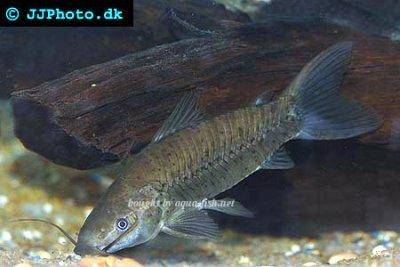Brown hoplo - Hoplosternum littorale
Scientific name: Hoplosternum littorale
Common name: Brown hoplo
Family: Callichthyidae
Usual size in fish tanks: 17 - 20 cm (6.69 - 7.87 inch)
014
Recommended pH range for the species: 6.5 - 7.5
Recommended water hardness (dGH): 6 - 22°N (107.14 - 392.86ppm)
0°C 32°F30°C 86°F
Recommended temperature: 22 - 27 °C (71.6 - 80.6°F)
The way how these fish reproduce: Spawning
Where the species comes from: South America
Temperament to its own species: peaceful
Temperament toward other fish species: peaceful
Usual place in the tank: Bottom levels
Food and Feeding
The Brown Hoplo (Hoplosternum littorale) is an omnivorous bottom-dweller that requires a varied diet for optimal health. They readily accept high-quality sinking pellets, catfish wafers, and meaty foods such as bloodworms, brine shrimp, and chopped earthworms. Occasional vegetable matter, such as blanched spinach or zucchini, can also be beneficial. These fish are enthusiastic feeders, so ensure that food is distributed evenly to prevent overconsumption by dominant individuals.
Origin and Natural Habitat
Native to South America, the Brown Hoplo is widely distributed from Venezuela to Argentina. They inhabit slow-moving or stagnant waters, including swamps, floodplains, and shallow lakes. Due to their ability to breathe atmospheric air, they can survive in environments with low oxygen levels, making them highly adaptable to different water conditions.
Sexing
Sexing Hoplosternum littorale can be challenging, as there are no highly visible external differences between males and females. However, males may develop more pronounced pectoral fin spines and display increased activity during breeding periods.
Breeding
The Brown Hoplo is a bubble-nest builder, an unusual characteristic for catfish species. To encourage breeding, floating plants should be provided to help stabilize the nest. The spawning ritual begins with the male and female swimming parallel to each other while touching barbels. Once the nest is built, the female lays up to 6000 eggs, which the male then fertilizes. The male takes on the responsibility of guarding the nest and will aggressively drive the female away. Eggs hatch within five days, and the fry become free-swimming shortly afterward.
For higher fry survival rates, removing the parent fish after spawning can be beneficial. An air-driven sponge filter should be used to prevent disruption of the bubble nest, as stronger filtration systems can easily destroy it. If spawning does not occur naturally, a cold water change can serve as a trigger.
Lifespan
With proper care, Hoplosternum littorale can live up to 4–8 years. Maintaining good water quality, a balanced diet, and a well-structured environment will contribute to their longevity.
Tank Requirements and Behavior
Brown Hoplos are peaceful and adaptable, making them excellent choices for community aquariums. However, they require ample swimming space, as they can grow up to 20 cm (7.87 inches). A tank of at least 150 liters (40 gallons) is recommended. Since they prefer soft, muddy, or sandy substrates, avoid sharp gravel that may injure their sensitive barbels. They enjoy hiding in driftwood or rock structures and should be provided with such shelter to reduce stress.
Suitable Tankmates
Being peaceful fish, Brown Hoplos can coexist well with similarly tempered species. Suitable tankmates include:
- Angelfish (Pterophyllum scalare)
- Corydoras Catfish (Corydoras spp.)
- Rainbowfish (Melanotaenia spp.)
- Gouramis (Trichogaster spp.)
- Tetras (Hyphessobrycon spp. & Paracheirodon spp.)
Suitable Plants
Brown Hoplos do not damage plants, making them suitable for planted aquariums. However, floating plants can be particularly useful in breeding setups. Recommended plant species include:
- Anubias (Anubias spp.)
- Java Fern (Microsorum pteropus)
- Amazon Sword (Echinodorus amazonicus)
- Water Lettuce (Pistia stratiotes)
Short Description
The Brown Hoplo (Hoplosternum littorale) is a hardy and adaptable bottom-dwelling catfish native to South America. Known for their unique bubble-nesting behavior, they are peaceful fish that thrive in community aquariums. Their ability to tolerate low-oxygen conditions makes them resilient and easy to care for. With proper tank conditions and a well-balanced diet, they can be a long-lasting and rewarding addition to any freshwater aquarium.
Pictures
Bought by aqua-fish.net from jjphoto.dk. One picture was provided by Janice.





 Aspidoras
Aspidoras  Giant
Giant  Hognosed
Hognosed  Emerald
Emerald  Cascarudo
Cascarudo  Acre
Acre  Adolfo’s
Adolfo’s  Bronze
Bronze  Agassizii’s
Agassizii’s  Spotted
Spotted  Skunk
Skunk  Corydoras
Corydoras  Fairy
Fairy  Corydoras
Corydoras  Pink
Pink  San
San  Bond’s
Bond’s  Spotted
Spotted  Tailspot
Tailspot  Concolor
Concolor  Cope’s
Cope’s  Sand’s
Sand’s  False
False  False
False  Ehrhardt’s
Ehrhardt’s  Elegant
Elegant  Saddle
Saddle  Fowler’s
Fowler’s  Gomezi
Gomezi  Palespotted
Palespotted  Guapore
Guapore  Dainty
Dainty  Mosaic
Mosaic  Imitator
Imitator  Julii
Julii  Leopard
Leopard  Black
Black  Slant-bar
Slant-bar  Bluespotted
Bluespotted  False
False  Bandit
Bandit  Mini
Mini  Napo
Napo  Corydoras
Corydoras  Blue
Blue  Nijssen’s
Nijssen’s  Ornate
Ornate  Peppered
Peppered  Panda
Panda  Albertini
Albertini  Pastaza
Pastaza  Corydoras
Corydoras  Many-spotted
Many-spotted  Pretty
Pretty  Dwarf
Dwarf  Iridescent
Iridescent  Reticulated
Reticulated  Bannertail
Bannertail  Robust
Robust  Schwartz’s
Schwartz’s  Black
Black  Longnosed
Longnosed  Seuss’
Seuss’  Smudge
Smudge  Masquerade
Masquerade  False
False  Millenium
Millenium  Pinkthroat
Pinkthroat  Sterba’s
Sterba’s  Longsnout
Longsnout  False
False  Miguelito
Miguelito  Twosaddle
Twosaddle  Xingu
Xingu  Black
Black  Porthole
Porthole  Flagtail
Flagtail  Spotted
Spotted